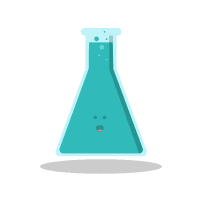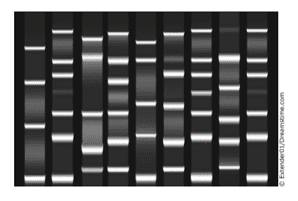
STAAR Biology High School 2018 - Past Paper
Quiz by TEKS Biology High School
Feel free to use or edit a copy
includes Teacher and Student dashboards
Measures 35 skills from
Measures 35 skills from
Track each student's skills and progress in your Mastery dashboards
With a free account, teachers can
- edit the questions
- save a copy for later
- start a class game
- automatically assign follow-up activities based on students’ scores
- assign as homework
- share a link with colleagues
- print as a bubble sheet
54 questions
Show answers
- Q1The results shown in the picture were obtained using a technique known as gel electrophoresis. This technique separates mixtures of DNA. In the picture nine different samples of DNA are compared. Gel electrophoresis can be used to -determine the differences in ages of a set of peopleidentify how closely two individuals are relatedidentify different blood types60sB.6.H: Genomes Of Organisms
- Q2The diagram illustrates the activity of vesicles during a cellular process. Which statement best explains the function of the vesicles?Transporting packaged molecules from the Golgi apparatus to be released out of the cellExtracting portions of the Golgi apparatus to be regenerated for growth within the cellExchanging genetic information between the Golgi apparatuses of separate cellsDelivering packaged materials to the Golgi apparatus for protein synthesis60sB.4.B: Cellular Processes
- Q3The graphs show the reaction rate for an enzyme across a range of temperatures and pH. Based on these data, this enzyme functions best at what temperature and pH?Temperature of 37°C and a pH of 6Temperature of 27°C and a pH of 4Temperature of 50°C and a pH of 10Temperature of 40°C and a pH of 860sB.9.C: Enzymes
- Q4The Indian leaf butterfly has traits that allow it to resemble a leaf. The bright colors of the monarch butterfly indicate that the butterfly tastes bad and can be poisonous. How does the appearance of these butterflies help them to survive?Both butterflies rely on camouflage to avoid predation.Both butterflies cooperate with one another to avoid predation.The Indian leaf butterfly is able to avoid predators while the monarch butterfly warns predators away.The Indian leaf butterfly frightens predators away while the monarch butterfly poisons predators before they can eat it.60sB.12.B: Variation & Adaptation
- Q5The female reproductive and endocrine systems work interactively for which main purpose?To maintain homeostasis by removing waste products from the bodyTo release neurotransmitters during times of stressTo control hormone levels to prepare the body for pregnancyTo exchange gases to support cellular aerobic respiration60sB.10.A: Animal Systems
- Q6Scientists can determine relatedness among organisms by comparing partial amino acid sequences. The table shows four partial amino acid sequences from four organisms. Which organism is the LEAST related to the other three organisms?Organism 1Organism 3Organism 2Organism 460sB.7.A: Common Ancestry
- Q7In the 1880s, Louis Pasteur developed a method of weakening viruses. The weakened viruses could be injected into healthy individuals. How is this method effective in fighting viral diseases?The weakened viruses attach to unaffected viruses in the host and interrupt the viral reproductive cycle.The rate of genetic mutation in the host is decreased due to the introduction of weakened viruses.The immune system develops antibodies in response to the weakened viruses.60sB.4.C: Viruses
- Q8In humans blood type is determined by the A, B, and O alleles. The A and B alleles are codominant to each other and dominant over the O allele. An individual with the AO genotype and an individual with the BO genotype can produce offspring with which of the following phenotypes?A, B, AB, or OA or B onlyO onlyA, B, or O only60sB.6.F: Genetic Combinations
- Q9Which of these best demonstrates mutualism between certain types of bacteria and humans?Bacteria in improperly prepared food is consumed by humans, causing food poisoning.Bacteria become resistant to antibacterial medication that humans use for treatment.Intestinal bacteria obtain nutrients from the gut and produce vitamin K used by humans.Invasive bacteria at an area of injury produce toxins that damage healthy tissues of the human body.60sB.12.A: Biological Relationships
- Q10What is the role of mRNA in expressing specialized structures?Providing information to form proteinsCreating bonds to form biomoleculesMaking energy available for cellular activities60sB.5.C: Cell Differentiation
- Q11A student used a microscope to study four members of the phylum Ciliophora. Members of this phylum move when propelled by hundreds of tiny cilia. Although these organisms belong to the same phylum, they are classified as different -ordersfamilieskingdomsspecies60sB.8.B: Hierarchical Classification
- Q12A mutation in which types of cells would only affect the organism and not future generations?Sperm cell and egg cellNerve cell and brain cellSperm cell and lung cellEgg cell and liver cell60sB.6.E: Changes In DNA
- Q13In the mid-1980s an aggressive strain of algae known as Caulerpa was accidentally introduced into the Mediterranean Sea when a seaside aquarium cleaned out its tanks. The algae contains a toxin that prevents native herbivores from consuming it. Caulerpa quickly spread over the sea floor, crowding out many species including sponges, corals, sea fans, and lobsters. Which statement explains the most likely impact Caulerpa has had on the biodiversity in the Mediterranean Sea?Users enter free textType an Answer60sB.12.F: Environmental Change
- Q14A sequence of a DNA template strand is shown. Which of these is the correct amino acid chain produced from the DNA template strand?Tryptophan - Phenylalanine - Leucine - Glycine - Asparagine - PhenylalanineSerine - Leucine - Proline - Asparagine - Lysine - ArginineArginine - Leucine - Proline - Asparagine - Lysine - ArginineTryptophan - Phenylalanine - Leucine - Glycine - Asparagine - Serine60sB.6.C: Transcription & Translation
- Q15Plant roots have extensions called root hairs. These root hairs are important in the homeostasis of the plant. Which statement best explains the importance of the root hairs to the stems and leaves of the plant?Root hairs convert minerals into glucose for immediate use by cells.Root hairs prevent water loss in leaves through transpiration and gas exchange.Root hairs decrease the need for osmosis and diffusion in vascular tissue.Root hairs increase the surface area of the roots for nutrient and water absorption.60sB.10.B: Plant Systems
